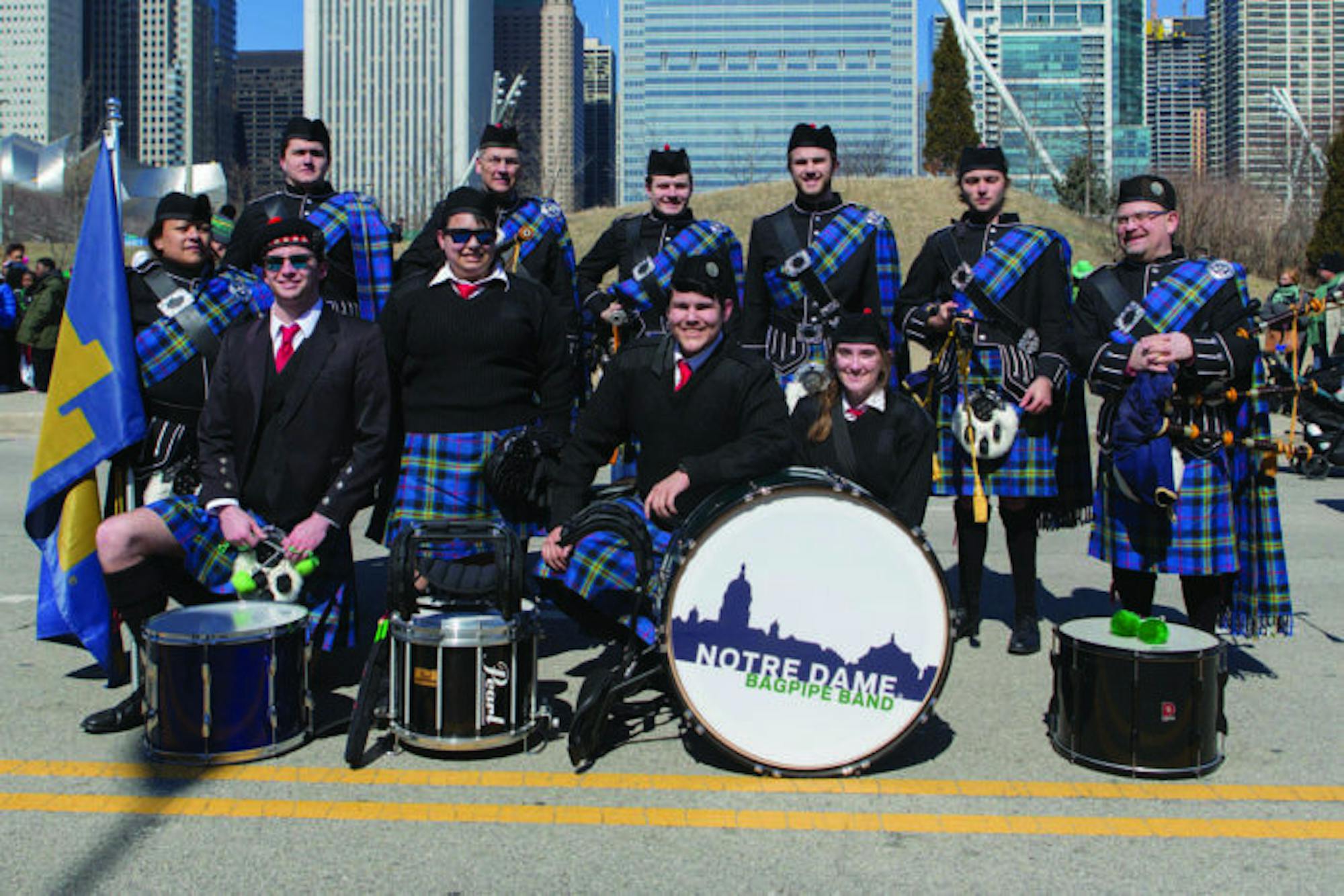Many deem the player walk from Hesburgh Library into the stadium before game time an iconically Notre Dame experience. This tradition, however, is relatively new.
The first bagpiping band at Notre Dame originated from the Irish Guard in 1949. But the bagpiping band Notre Dame knows today is not the same.
“The original band didn’t last long because the bagpipes had to be let go for several reasons,” faculty co-advisor of the band, professor Dominic Vachon said.
Vachon explained that bagpipes cannot last for long in weather below 40 degrees because the reeds start freezing.
“In those days, the bagpipes would lock up after staying in the stadium all that time,” he said.
The size of the band also created issues, Vachon said.
“The other problem then was that there were only eight or nine Irish Guard, and eight or nine pipers does not fill that stadium,” Vachon said.
Finally, Vachon said, the way the band recruited bagpipers created issues.
“The third reason, which we know from Lee Tavis, a professor emeritus, was the original way they chose pipers in the Irish Guard,” Vachon said. “They went through the band and drafted people to be bagpipers. And that’s not a great way to get people to learn an instrument.”
So they kept the Irish Guard and got rid of the bagpipes.
Years later, then-student Paul Harren formed the band that Notre Dame knows today. Vachon became an advisor to the band about a year after its existence.
The band started playing in front of the Knights of Columbus area before the football games with a case open to receive donations.
“Pretty quickly we were able to afford kilts,” Vachon said.
But the administration soon made the decision that it was appropriate for the band to wear the Notre Dame tartan at Notre Dame functions.
“The tremendous enthusiasm of Notre Dame football fans is what made us into a tradition,” Vachon said.
Nowadays, the band is comprised of faculty, staff and students of Notre Dame, Saint Mary’s and Holy Cross. Longstanding co-advisors to the group are Vachon and professor Dan Gezelter. Sophomore Tom Garvey is serving his first year as pipe major.
Garvey said there is a core group of five pipers and three drummers in the band this school year.
Though faculty and staff are in the band, it is student-run.
“When [Gezelter] and I are in the band, we are each one of the pipers,” Vachon said. “The students make the decisions about performances.”
Additionally, Garvey and Gezelter said for various games people will join them on game days.
“We’ve even had prospective students come and play with us,” Gezelter said.
“Even if they don’t know many of the songs, we are happy to have them dress up and stand with us while we play,” Garvey said.
The band plays many times throughout the year, but the three main events are the the pre-game show under or in front of the dome, the player walk and the St. Patrick’s day parade each year in Chicago. The band is also often asked to play at tailgates and other special events.
The player walk just recently became a tradition.
“When coach [Brian] Kelly first started, he called us up and asked if we could pipe the players into the stadium. We thought it was a one-time event, but we were thrilled to do it,” Vachon said. “The next home game we were sitting around, and coach Kelly called the pipe major and asked if we were piping the team in again.”
The band has escorted the team from Hesburgh Library to the stadium ever since to the same three tunes Kelly first requested: “The Minstrel Boy”, “Kelly the Boy from Killane” and “Mairi’s Wedding.”
“We didn’t use to do player walks or play under the dome but once we do them a couple times in a row everyone expects them,” Gezelter said.
Vachon said he thought Kelly must have had a sense of the purpose of bagpipes. Vachon said they are best used for processing people in, or in this case, marching them to victory.
Thus, the tradition of the player walk was born.
“You don’t realize you’re part of a tradition until you’re right in the middle,” Vachon said.
In the spring, the band will make their annual trip to Chicago to play in the St. Patrick’s day parade. But before the parade, which is sponsored by the Plumbers Union, the band plays on the boat that dyes the river green, Garvey and Gezelter said.
The band is always looking for new members regardless of experience. Garvey, Gezelter and Vachon encourage anyone interested to stop by practice on Wednesdays at 6:30 p.m. or Sundays at 2:00 p.m.
“We’ve had a number of people though who just picked it up right when they got here or they knew another instrument,” Vachon said.
To be a part of the band is to be a part of tradition, Garvey said.
“Bagpipes really tie us back to our Celtic roots,” Garvey said. “We call ourselves the Fighting Irish. It makes sense that we are really showing all our sides of being Irish even though we play Scottish pipes.”
Catch the band’s performance Saturday at 3:30 p.m. inside Main Building under the dome or at 5:15 p.m. in front of Hesburgh Library for the player walk to the stadium.













